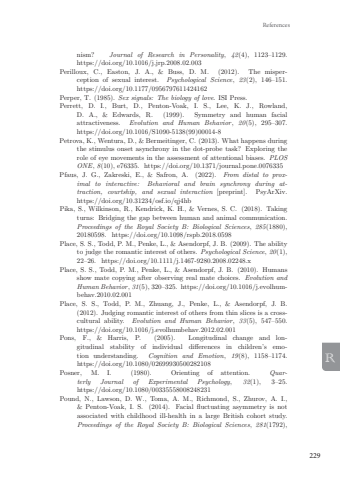Page 231 - Demo
P. 231
229ReferencesRnism? Journal of Research in Personality, 42(4), 1123–1129.https://doi.org/10.1016/j.jrp.2008.02.003Perilloux, C., Easton, J. A., & Buss, D. M. (2012). The misperception of sexual interest. Psychological Science, 23(2), 146–151.https://doi.org/10.1177/0956797611424162Perper, T. (1985). Sex signals: The biology of love. ISI Press.Perrett, D. I., Burt, D., Penton-Voak, I. S., Lee, K. J., Rowland,D. A., & Edwards, R. (1999). Symmetry and human facialattractiveness. Evolution and Human Behavior, 20(5), 295–307.https://doi.org/10.1016/S1090-5138(99)00014-8Petrova, K., Wentura, D., & Bermeitinger, C. (2013). What happens duringthe stimulus onset asynchrony in the dot-probe task? Exploring therole of eye movements in the assessment of attentional biases. PLOSONE, 8(10), e76335. https://doi.org/10.1371/journal.pone.0076335Pfaus, J. G., Zakreski, E., & Safron, A. (2022). From distal to proximal to interactive: Behavioral and brain synchrony during attraction, courtship, and sexual interaction [preprint]. PsyArXiv.https://doi.org/10.31234/osf.io/qj4hbPika, S., Wilkinson, R., Kendrick, K. H., & Vernes, S. C. (2018). Takingturns: Bridging the gap between human and animal communication.Proceedings of the Royal Society B: Biological Sciences, 285(1880),20180598. https://doi.org/10.1098/rspb.2018.0598Place, S. S., Todd, P. M., Penke, L., & Asendorpf, J. B. (2009). The abilityto judge the romantic interest of others. Psychological Science, 20(1),22–26. https://doi.org/10.1111/j.1467-9280.2008.02248.xPlace, S. S., Todd, P. M., Penke, L., & Asendorpf, J. B. (2010). Humansshow mate copying after observing real mate choices. Evolution andHuman Behavior, 31(5), 320–325. https://doi.org/10.1016/j.evolhumbehav.2010.02.001Place, S. S., Todd, P. M., Zhuang, J., Penke, L., & Asendorpf, J. B.(2012). Judging romantic interest of others from thin slices is a crosscultural ability. Evolution and Human Behavior, 33(5), 547–550.https://doi.org/10.1016/j.evolhumbehav.2012.02.001Pons, F., & Harris, P. (2005). Longitudinal change and longitudinal stability of individual differences in children’s emotion understanding. Cognition and Emotion, 19(8), 1158–1174.https://doi.org/10.1080/02699930500282108Posner, M. I. (1980). Orienting of attention. Quarterly Journal of Experimental Psychology, 32(1), 3–25.https://doi.org/10.1080/00335558008248231Pound, N., Lawson, D. W., Toma, A. M., Richmond, S., Zhurov, A. I.,& Penton-Voak, I. S. (2014). Facial fluctuating asymmetry is notassociated with childhood ill-health in a large British cohort study.Proceedings of the Royal Society B: Biological Sciences, 281(1792),Iliana Samara 17x24.indd 229 08-04-2024 16:38


